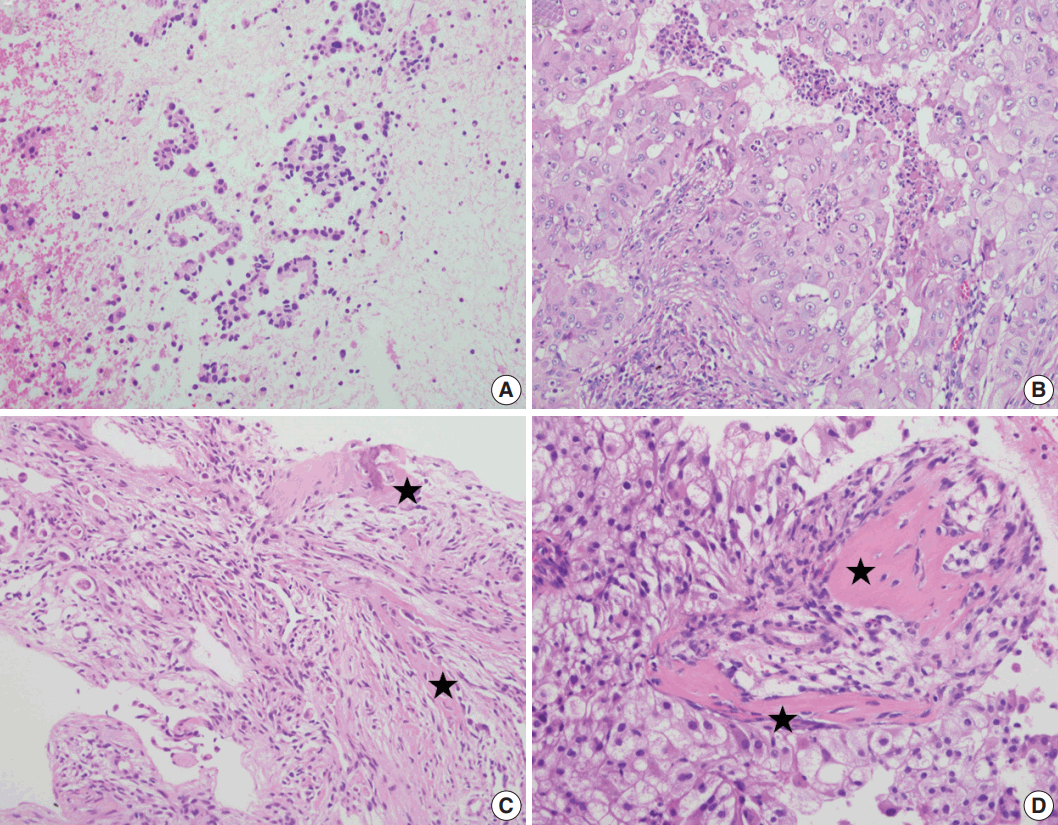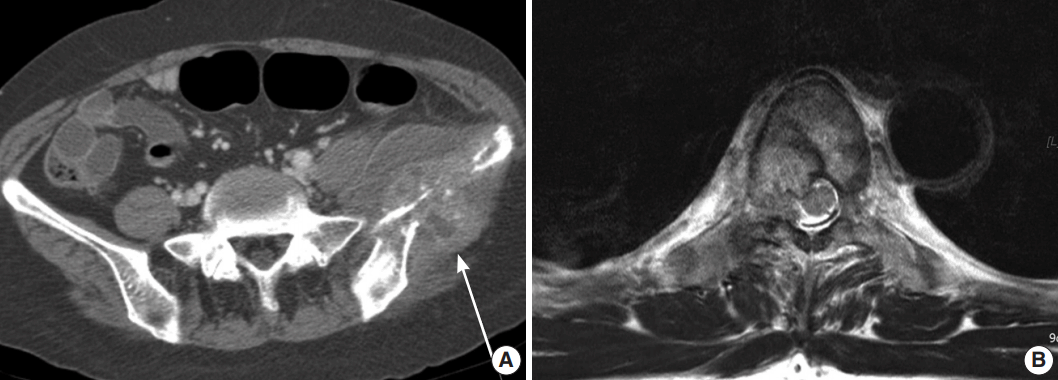Articles
- Page Path
- HOME > J Pathol Transl Med > Volume 52(2); 2018 > Article
-
Brief Case Report
Osteosarcomatous Differentiation in Rebiopsy Specimens of Pulmonary Adenocarcinoma with EGFR-TKI Resistance - Hyein Ahn, Hyun Jung Kwon, Eunhyang Park1, Hyojin Kim, Jin-Haeng Chung,
-
Journal of Pathology and Translational Medicine 2018;52(2):130-132.
DOI: https://doi.org/10.4132/jptm.2016.11.17
Published online: April 4, 2017
Department of Pathology, Seoul National University Bundang Hospital, Seongnam, Korea
1Department of Pathology, Seoul National University Hospital, Seoul, Korea
- Corresponding Author Jin-Haeng Chung, MD, PhD Department of Pathology, Seoul National University Bundang Hospital, 82 Gumi-ro 173beon-gil, Bundang-gu, Seongnam 13620, Korea Tel: +82-31-787-7713, Fax: +82-31-787-4012, E-mail: chungjh@snu.ac.kr
• Received: September 28, 2016 • Revised: November 13, 2016 • Accepted: November 17, 2016
© 2018 The Korean Society of Pathologists/The Korean Society for Cytopathology
This is an Open Access article distributed under the terms of the Creative Commons Attribution Non-Commercial License (http://creativecommons.org/licenses/by-nc/4.0) which permits unrestricted non-commercial use, distribution, and reproduction in any medium, provided the original work is properly cited.
- Case 1
- A 55-year-old female, non-smoker presenting chronic cough was found to have a mass in the right upper lobe of lung with disseminated intrapulmonary metastasis on computed tomography (CT). CT-guided biopsy of the pulmonary mass revealed a moderately differentiated adenocarcinoma (Fig. 1A) harboring EGFR exon 19 deletion. The initial positron emission tomography–CT and brain magnetic resonance imaging showed metastatic lesions in the left ilium and bilateral cerebral cortex. As first-line therapy, she received one cycle of conventional chemotherapy for 8 days, and then started gefitinib as second-line therapy. After 1 year of continuous gefitinib treatment, radiologic evaluation showed a larger number of metastatic nodules in lung and increased extent of the left iliac metastases with extraosseous ossification (Fig. 2A).
- Case 2
- A 58-year-old man who had undergone right upper lobectomy of lung was diagnosed as adenocarcinoma (Fig. 1B) with pT-1N0M0 harboring an EGFR exon 19 deletion mutation. Three years after surgery, metastatic lesions were detected in the right lower lobe and pleura on radiologic findings. He received conventional chemotherapy for 3 months, and then started gefitinib. After 15 months of continuous gefitinib treatment, second biopsy for the pulmonary lesion confirmed T790M mutation, and additional metastatic lesions found in T2 and T5 vertebral bodies (Fig. 2B) were removed by surgical curettage.
- Rebiopsy of the metastatic bone lesions of these two patients was performed. Microscopic findings of the tumor showed adenocarcinoma merging with poorly differentiated sarcomatous components. Remarkably, there were spindle shaped sarcomatous tumor cells with eosinophilic cytoplasm producing ill-defined pink acellular lace-like osteoid. These osteoid components were closely associated with the tumor cells and deposited as disorganized features. The sarcomatous neoplastic cells intermingled with osteoid demonstrate unequivocal features of malignancy, which is different from reactive osteoid or callus formation (Fig. 1C, D). EGFR mutation status was same as that of primary lung specimen, and immunohistochemistry showed vimentin expression and decreased E-cadherin.
CASE REPORT
- It is known that the resistance to EGFR-TKI is due to various mechanisms. Rebiopsy is usually used to detect the underlying molecular mechanism of resistance; however, meticulous histologic examination is very important to identify the change in cancer phenotype. Histological transformation of adenocarcinoma such as transformation into SCC and EMT is one of the discovered mechanisms in the acquired resistance to EGFR-TKI [1]. EMT is characterized by loss of cell adhesion and acquisition of mesenchymal features, showing morphological change from the epithelial phenotype to the mesenchymal fibroblastoid phenotype. Osteosarcomatous differentiation highly represents EMT features which may contribute to the acquired resistance to EGFR-TKIs. To the best of our knowledge, this is the first report to describe pulmonary adenocarcinoma with osteosarcomatous differentiation in rebiopsy specimens of EGFR-TKI resistant patients.
- Here, we describe two cases showing osteosarcomatous differentiation with sarcomatoid features after EGFR-TKI treatment. The malignant osteoid components were distinguished from destroyed and/or regenerating bone elements by their morphology and surrounding poorly differentiated sarcomatous cells in histologic findings. In addition, the ossification of extraosseous sites in radiologic findings is helpful. As the evaluation of metastatic sites for rebiopsy were bone lesions in both patients, the tumor microenvironment may have contributed to the transformation from adenocarcinoma to osteosarcomatous phenotype [2]. A few previous studies suggested that a bone environment is essential for osteosarcoma development from transformed mesenchymal stem cells [3]. Our findings suggest that the differences of the intrinsic nature between epithelial and osteosarcomatous mesenchymal cancers may be the cause of the acquired resistance to EGFR-TKI [4]. In addition, Mink et al. [5] demonstrated that the tumor stroma having cancer-associated fibroblast related to EMT plays an important role in limiting responsiveness to EGFR-TKI.
- The phenotypic change in cancer including EMT and histological transformation has been identified as a mechanism of resistance to EGFR-TKI; however, the specific underlying biologic mechanism remains unclear. Further investigations are needed to explain the mechanism of EMT and tumor microenvironment involved in EGFR-TKI resistance.
DISCUSSION
Fig. 1.Histologic findings. First biopsy of case 1 (A) and case 2 (B). Microscopic finding of first biopsy reveals adenocarcinoma showing glandular differentiation. Rebiopsy of case 1 (C) and case 2 (D). Microscopic finding shows sarcomatous tumor cells producing osteoid (asterisks).


Fig. 2.Radiologic findings. Case 1 (A). Pelvic magnetic resonance imaging demonstrates left iliac metastases with ossification at the extraosseous soft tissue (arrow). Case 2 (B). Computed tomography reveals T2 and T5 vertebral bodies metastases.


- 1. Sequist LV, Waltman BA, Dias-Santagata D, et al. Genotypic and histological evolution of lung cancers acquiring resistance to EGFR inhibitors. Sci Transl Med 2011; 3: 75ra26.PubMedPMC
- 2. Quail DF, Joyce JA. Microenvironmental regulation of tumor progression and metastasis. Nat Med 2013; 19: 1423-37. ArticlePubMedPMCPDF
- 3. Rubio R, Abarrategi A, Garcia-Castro J, et al. Bone environment is essential for osteosarcoma development from transformed mesenchymal stem cells. Stem Cells 2014; 32: 1136-48. ArticlePubMedPDF
- 4. Byers LA, Diao L, Wang J, et al. An epithelial-mesenchymal transition gene signature predicts resistance to EGFR and PI3K inhibitors and identifies Axl as a therapeutic target for overcoming EGFR inhibitor resistance. Clin Cancer Res 2013; 19: 279-90. ArticlePubMedPDF
- 5. Mink SR, Vashistha S, Zhang W, Hodge A, Agus DB, Jain A. Cancer-associated fibroblasts derived from EGFR-TKI-resistant tumors reverse EGFR pathway inhibition by EGFR-TKIs. Mol Cancer Res 2010; 8: 809-20. ArticlePubMedPMCPDF
REFERENCES
Figure & Data
References
Citations
Citations to this article as recorded by 

- Adipogenesis induces growth inhibition of dedifferentiated liposarcoma
Yu Jin Kim, Dan Bi Yu, Mingi Kim, Yoon‐La Choi
Cancer Science.2019; 110(8): 2676. CrossRef
 PubReader
PubReader ePub Link
ePub Link-
 Cite this Article
Cite this Article
- Cite this Article
-
- Close
- Download Citation
- Close
- Figure
Osteosarcomatous Differentiation in Rebiopsy Specimens of Pulmonary Adenocarcinoma with EGFR-TKI Resistance


Fig. 1. Histologic findings. First biopsy of case 1 (A) and case 2 (B). Microscopic finding of first biopsy reveals adenocarcinoma showing glandular differentiation. Rebiopsy of case 1 (C) and case 2 (D). Microscopic finding shows sarcomatous tumor cells producing osteoid (asterisks).
Fig. 2. Radiologic findings. Case 1 (A). Pelvic magnetic resonance imaging demonstrates left iliac metastases with ossification at the extraosseous soft tissue (arrow). Case 2 (B). Computed tomography reveals T2 and T5 vertebral bodies metastases.
Fig. 1.
Fig. 2.
Osteosarcomatous Differentiation in Rebiopsy Specimens of Pulmonary Adenocarcinoma with EGFR-TKI Resistance

 E-submission
E-submission




